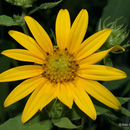en
names in breadcrumbs


USA: AL , AR , CT , DE , FL , GA , IL , IN , IA , KY , LA , ME , MD , MA , MI , MS , MO , NH , NJ , NY , NC , OH , OK , PA , RI , SC , TN , VT , VA , WV , WI , DC (NPIN, 2009)
Canada: ON , QC (NPIN, 2009)
USDA Native Status: L48(N), CAN(N) (NPIN, 2009)
Flowers are yellow. This is a daisy-like flower is made up of many petal-like rays. (Hultman, 1978) Flowers have 8-15 yellow rays and a yellow disk. Inflorescence (cymose) one to several heads at the ends of the stiff branches, bracts (phyllaries) loosely arranged and often with reflexed tips. (UW, 2009)
Fruit is a capsule. (NPIN, 2009)
Leaves Thick, slender leaves are rough on top and hairy underneath. They are attached in pairs by short stalks. (Hultman, 1978) Leaves are all opposite and usually stalkless or on a very short stalk. They are rough above, sparsely hairy below, and narrowly to widely lance-like. The base is straight to broadly rounded, and the leaf ends in a sharp tip. (UW, 2009)
Stems are smooth. (Hultman, 1978) Stems are smooth below the inflorescence. (NPIN, 2009)
Plant is 2-6.5' tall. (Hultman, 1978) The plant is 20"-60" tall. (UW, 2009)
Flowers head is 1 1/2"-3" wide. (UW, 2009)
Helianthus divaricatus, commonly known as the rough sunflower,[3] woodland sunflower,[4] or rough woodland sunflower,[5] is a North American species perennial herb in the family Asteraceae. It is native to central and eastern North America, from Ontario and Quebec in the north, south to Florida and Louisiana and west to Oklahoma and Iowa.[6]
Helanthus divaricatus commonly occurs in dry, relatively open sites. The showy yellow flowers emerge in summer through early fall.[7]
The woodland sunflower is similar to Helianthus hirsutus, but its stem is rough. It is up to 1.5 m tall with short stalked, lanceolate to oval leaves, 1–8 cm wide with toothed margins. Its flowers have 8 to 15 rays, each 1.5 to 3 cm (0.6-1.2 inches) long, surrounding an orange or yellowish brown central disk.[5] The plant attracts birds and butterflies. The Latin specific epithet divaricatus means spreading in a straggling manner.[8]
Helianthus divaricatus, commonly known as the rough sunflower, woodland sunflower, or rough woodland sunflower, is a North American species perennial herb in the family Asteraceae. It is native to central and eastern North America, from Ontario and Quebec in the north, south to Florida and Louisiana and west to Oklahoma and Iowa.
Helanthus divaricatus commonly occurs in dry, relatively open sites. The showy yellow flowers emerge in summer through early fall.
The woodland sunflower is similar to Helianthus hirsutus, but its stem is rough. It is up to 1.5 m tall with short stalked, lanceolate to oval leaves, 1–8 cm wide with toothed margins. Its flowers have 8 to 15 rays, each 1.5 to 3 cm (0.6-1.2 inches) long, surrounding an orange or yellowish brown central disk. The plant attracts birds and butterflies. The Latin specific epithet divaricatus means spreading in a straggling manner.